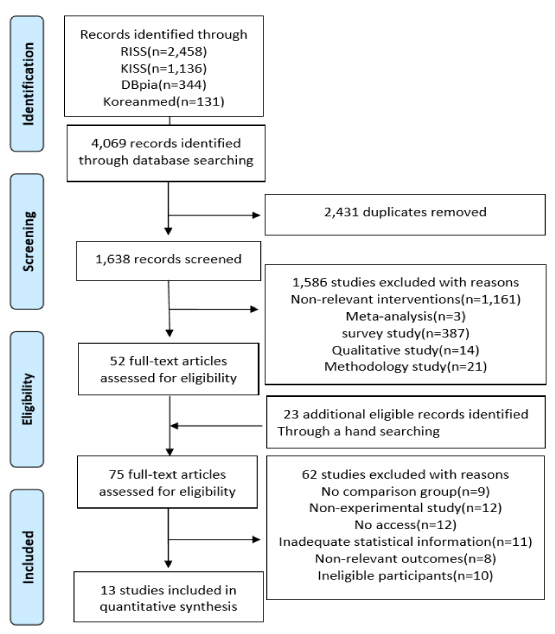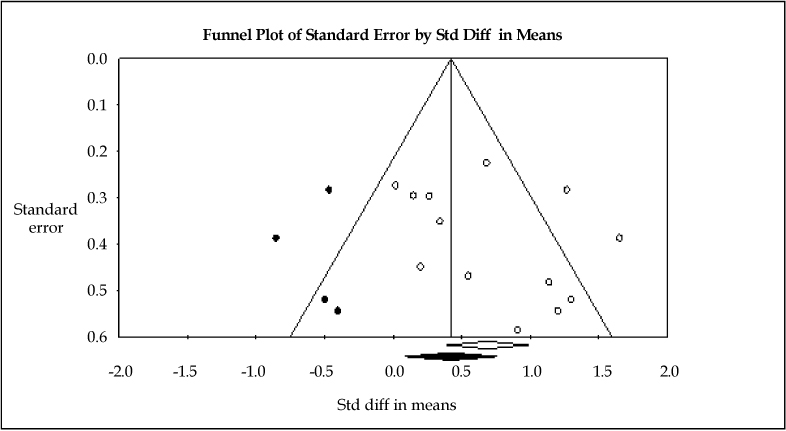J Korean Acad Psychiatr Ment Health Nurs.
2016 Sep;25(3):237-248. 10.12934/jkpmhn.2016.25.3.237.
Effects of Ego-resilience Interventions among Children and Adolescents in Korea: A Meta-analysis
- Affiliations
-
- 1Department of Nursing, Suwon Women's University, Suwon, Korea. firstnun@swc.ac.kr
- KMID: 2354870
- DOI: http://doi.org/10.12934/jkpmhn.2016.25.3.237
Abstract
- PURPOSE
This study was a meta-analysis planned to exam effects of ego-resilience interventions among children and adolescents in Korea.
METHODS
Search for relevant articles included several electronic databases and hand-search from article references. Thirteen studies met inclusion criteria from 1,638 studies. Comprehensive Meta-Analysis (version 3) and Review Manager (version 5) were used to analyze effect sizes, investigate possible causes of heterogeneity and check publication bias with a funnel plot and its trim-and-fill analysis.
RESULTS
Overall effect size of ego-resilience interventions were medium (Hedges'g=0.66) and medium heterogeneity (I²=54%). Subgroup analysis was performed to estimate causes of heterogeneity. The effect size for normal populations (g=0.70) was larger than for risk populations (g=0.64). Interventions for primary school students (g=0.74) were more effective than interventions for adolescents (g=0.51). Interventions in the community (g=0.72) shown larger effect size than intervention at school (g=0.51). Art therapy (g=0.79) had a better effect than cognitive behavior therapy (g=0.62). Interventions with over 1,000 minutes (g=1.10) and intervention with over 11 sessions (g=1.40) were effective. This study found no significant publication bias.
CONCLUSION
Based on current findings, there is obvious evidence that ego-resilience interventions have significant effects in improving ego-resilience among children and adolescents in Korea.
Keyword
MeSH Terms
Figure
Reference
-
1. Cho BH. Development of daily hassles scale and daily hassles coping behaviors scale for elementary school children. J Child Educ. 2006; 15(3):5–21.2. Statistics Korea. 2015 Youth Statistics [Internet]. 2015. 04. cited 2016 Jun 28. Available from: http://www.kostat.go.kr/portal/korea/kor_nw/2/1/index.board?bmode=read&aSeq=335384.3. Tugade MM, Fredrickson BL. Resilient individuals use positive emotions to bounce back from negative emotional experiences. J Pers Soc Psychol. 2004; 86(2):320–333. DOI: 10.1037/0022-3514.86.2.320.
Article4. Block J, Kremen AM. IQ and ego-resiliency: conceptual and empirical connections and separateness. J Pers Soc Psychol. 1996; 70(2):349–361. DOI: 10.1037/0022-3514.70.2.349.
Article5. Beutel ME, Glaesmer H, Decker O, Fischbeck S, Braähler E. Life satisfaction, distress, and resiliency across the life span of women. Menopause. 2009; 16(6):1132–1138. DOI: 10.1097/gme.0b013e3181a857f8.
Article6. Burns RA, Anstey KJ. The Connor-Davidson Resilience Scale (CD-RISC): testing the invariance of a uni-dimensional resilience measure that is independent of positive and negative affect. Pers Individ Dif. 2010; 48(5):527–531. DOI: 10.1016/j.paid.2009.11.026.
Article7. Lee YS. Theoretical consideration about a resilience concept. Korean J Play Ther. 2013; 16(4):259–284.8. Bae J, Park HJ, Yang MK. Effects of a Self-discovery Program for Ego resilience, Self-esteem, Stress and Depression in Elementary School Students. J Korean Acad Psychiatr Ment Health Nurs. 2012; 21(3):210–219.
Article9. Park WJ, Kim MY. Effects of literary therapy intervention on ego resilience and maladaptive behavior in children of broken homes. J Korean Acad Psychiatr Ment Health Nurs. 2011; 20(2):143–156. DOI: 10.12934/jkpmhn.2011.20.2.143.
Article10. Yoe JY. The effect of music therapy activities on resilience of internet addicted adolescents. Korean J Music Ther. 2012; 14(1):21–40.
Article11. Hwang SD. Publication baias in meta-analysis: its meaning and analysis. Korean J Human Development. 2016; 23(1):1–19. DOI: 10.15284/kjhd.2016.23.1.1.12. Leppin AL, Bora PR, Tiburt JC, Gionfriddo MR, ZeballosPalacios C, Dulohery MM, et al. The efficacy of resiliency training programs: a systematic review and meta-analysis of randomized trials. PLoS One. 2014; 9(10):1–15. DOI: 10.1371/journal.pone.0111420.
Article13. Zenner C, Herrnleben-Kurz S, Walach H. Mindfulness-based interventions in schools-a systematic review and meta-analysis. Front Psychol. 2014; 5(603):1–20. DOI: 10.3389/fpsyg.2014.00603.
Article14. Hu T, Zhang D, Wang J. A meta-analysis of the trait resilience and mental health. Pers Individ Dif. 2015; 76:18–27. DOI: 10.1016/j.paid.2014.11.039.
Article15. Connor KM, Davidson JR. Development of a new resilience scale: the Connor-Davidson Resilience Scale (CD-RISC). Depress Anxiety. 2003; 18(2):76–82. DOI: 10.1002/da.10113.
Article16. Harvey J, Delfabbro PH. Psychological resilience in disadvantaged youth: a critical overview. Australian Psychologist. 2004; 39(1):3–13. DOI: 10.1080/00050060410001660281.
Article17. Dray J, Bowman J, Wolfenden L, Campbell E, Freund M, Hodder R, et al. Systematic review of universal resilience interventions targeting child and adolescent mental health in the school setting: review protocol. Syst Rev. 2015; 4:186–194. DOI: 10.1186/s13643-015-0172-6.
Article18. Scottish Intercollegiate Guidelines Network. SIGN 50: a guideline developer's handbook [Internet]. 2012. 05. cited 2016 Mar 29. Available from: http://www.sign.ac.uk/guidelines/fulltext/50/index.html.19. DerSimonian R, Laird N. Meta-analysis in clinical trials. Control Clin Trials. 1986; 7(3):177–188.
Article20. Cohen J. Statistical power analysis. Curr Dir Psychol Sci. 1992; 1(3):98–101. DOI: 10.1111/1467-8721.ep10768783.
Article21. Higgins JP, Thompson SG, Deeks JJ, Altman DG. Measuring inconsistency in meta-analyses. BMJ. 2003; 327(7414):557–560. DOI: 10.1136/327.7414.557.
Article22. Duval S, Tweedie R. A nonparametric "trim and fill" method of accounting for publication bias in meta-analysis. J Am Stat Assoc. 2000; 95(449):89–98. DOI: 10.1080/01621459.2000.10473905.
Article23. Egger M, Davey Smith G, Schneider M, Minder C. Bias in meta-analysis detected by a simple, graphical test. BMJ. 1997; 315(7109):629–634.
Article24. Windle G, Bennett KM, Noyes J. A methodological review of resilience measurement scales. Health Qual Life Outcomes. 2011; 9(8):1–18. DOI: 10.1186/1477-7525-9-8.
Article25. Kim KK, Im SI, Park IS. Meta-analysis of self-esteem improvement program. J Educational Research. 2015; 13(1):21–42.
- Full Text Links
- Actions
-
Cited
- CITED
-
- Close
- Share
- Similar articles
-
- Influence of Parents' Rearing Attitudes Perceived by Bullied Children on Bullying: Ego-Resilience Mediation
- Effects of Literary Therapy Intervention on Ego Resilience and Maladaptive Behavior in Children of Broken Homes
- The Influence of Parental Behavior on Ego Resilience of Korean Middle School Student
- The Mediating Effect of Ego-Resilience on the Relationship between Emotional Intelligence and Nursing Performance among Clinical Nurses
- The Effects of Empathy on Interpersonal Relationship through the Mediating Effect of Ego-resilience in Nursing Students




